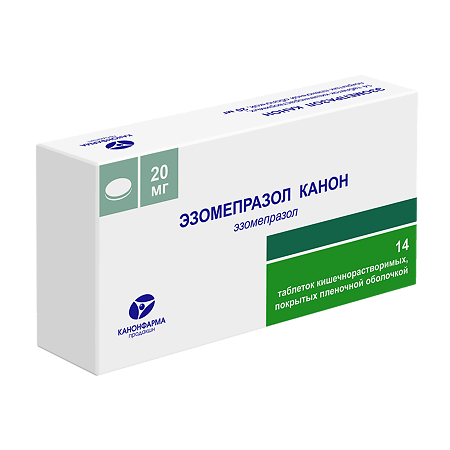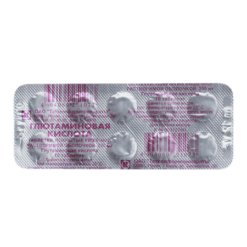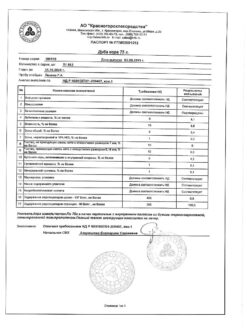No products in the cart.
Esomeprazole Canon, 20 mg 14 pcs
€1.00
Out of stock
(E-mail when Stock is available)
EAN: 4606486023340
SKU: 255989
Categories: Medicine, Stomach, intestines, liver, Ulcer and gastritis
Description
A gastric gland secretion reducing agent is a proton pump inhibitor.
Pharmacodynamics
Esomeprazole is the S-isomer of omeprazole and reduces gastric hydrochloric acid secretion by specifically inhibiting the proton pump in the parietal cells of the stomach. S- and R-isomers of omeprazole have similar pharmacodynamic activity.
Mechanism of action
Esomeprazole is a weak base that converts to its active form in the highly acidic environment of the secretory tubules of the parietal cells of the gastric mucosa and inhibits the proton pump enzyme H+/K+ – ATPase, with inhibition of both basal and stimulated hydrochloric acid secretion.
Influence on gastric hydrochloric acid secretion
After oral administration of 20 mg or 40 mg, the effects of esomeprazole develop within 1 hour. When administered daily for 5 days at a dose of 20 mg once daily, the average maximum concentration of hydrochloric acid after pentagastrin stimulation is decreased by 90% (when measured 6-7 hours after taking the drug on day 5 of therapy).
In patients with gastroesophageal reflux disease (GERD) and the presence of clinical symptoms after 5 days of daily oral administration of esomeprazole at a dose of 20 mg or 40 mg, intragastric pH values above 4.0 were maintained for an average of 13 and 17 hours of 24 hours. On the background of esomeprazole at a dose of 20 mg per day, intragastric pH values above 4.0 were maintained for at least 8, 12, and 16 hours in 76%, 54%, and 24% of patients, respectively.
The correlation between the drug concentration in plasma and inhibition of hydrochloric acid secretion was detected (to estimate the concentration we used parameter AUC – area under the curve “concentration – time”.
Therapeutic effect achieved as a result of inhibition of hydrochloric acid secretion
When taking the drug in a dose of 40 mg healing of reflux esophagitis occurs in approximately 78% of patients after 4 weeks of therapy and in 93% of patients after B weeks of therapy.
Treatment with esomeprazole in a dose of 20 mg twice daily in combination with appropriate antibiotics for one week leads to successful eradication of Helicobacter pylori in approximately 90% of patients. Patients with uncomplicated peptic ulcer disease after a one-week course of eradication do not require subsequent monotherapy with drugs that reduce gastric gland secretion for ulcer treatment and elimination of symptoms.
Esomeprazole has been shown to be effective in peptic ulcer bleeding confirmed endoscopically.
Other effects related to inhibition of hydrochloric acid secretion
During treatment with drugs that decrease gastric gland secretion, plasma gastrin concentration increases as a result of decreased hydrochloric acid secretion. A chromogranin A (CgA) concentration increases as a result of decreased hydrochloric acid secretion. Increased concentration of CgA may affect the results of examinations for detection of neuroendocrine tumors. To prevent this effect, esomeprazole should be temporarily discontinued 5 days before CgA testing.
In patients receiving esomeprazole for a long time, an increase in enterochromaffin-like cells has been observed, probably related to an increase in plasma gastrin concentration.
Patients taking drugs that reduce gastric gland secretion over a long period of time are more likely to have glandular cysts in the stomach. These phenomena are due to physiological changes resulting from marked inhibition of hydrochloric acid secretion. The cysts are benign and undergo reverse development.
The use of drugs that inhibit the secretion of hydrochloric acid in the stomach, including proton pump inhibitors, is accompanied by an increase in the gastric content of microbial flora normally present in the gastrointestinal tract. Use of proton pump inhibitors may lead to a slight increase in the risk of gastrointestinal tract infections caused by bacteria of the genus Salmonella spp. and Campylibacter spp. and probably Clostridium difficile in hospitalized patients.
In two comparative studies with ranitidine, esomeprazole showed better efficacy with respect to the treatment of gastric ulcers in patients treated with nonsteroidal anti-inflammatory drugs (NSAIDs), including selective cyclooxygenase-2 (COX-2) inhibitors.
Pharmacokinetics
Absorption and distribution
. Esomeprazole is unstable in acidic environments, so enteric-coated tablets are used for oral administration. Under in vivo conditions only a small part of esomeprazole is converted to the R-isomer.
Eating slows down and reduces absorption of esomeprazole in the stomach, but this does not significantly affect the effectiveness of inhibiting hydrochloric acid secretion.
The drug is rapidly absorbed: the maximum concentration (Cmax) in plasma is reached 1-2 hours after administration. Absolute bioavailability of esomeprazole after a single dose of 40 mg is 64% and increases to 89% after daily dosing once daily. For the 20 mg dose of esomeprazole these figures are 50% and 68%, respectively. The volume of distribution at equilibrium concentration in healthy subjects is approximately 0.22 l/kg body weight. Esomeprazole is 97% bound to plasma proteins.
Metabolism and excretion
Esomeprazole undergoes metabolism involving cytochrome P450 isoenzymes. The main part is metabolized with the participation of the specific polymorphic isoenzyme CYP2C19, with the formation of hydroxylated and demethylated metabolites of esomeprazole. The metabolism of the remaining part is performed by the CYP3A4 isoenzyme, which produces sulfo-derivative of esomeprazole, which is the main metabolite determined in plasma.
The parameters below mainly reflect the nature of pharmacokinetics in patients with increased activity of CYP2C19 isoenzyme.
The total clearance is approximately 17 l/h after a single dose of the drug and 9 l/h after multiple doses. The elimination half-life (T½) is 1.3 hours with systemic administration once daily. AUC increases with repeated administration of esomeprazole.
The dose-dependent increase in AUC with repeated administration of esomeprazole is nonlinear, which is a consequence of a decrease in metabolism during “first passage” through the liver and a decrease in systemic clearance, probably caused by inhibition of the CYP2C19 isoenzyme by esomeprazole and/or its sulfo derivatives.
Esomeprazole is completely eliminated from the blood plasma between doses and does not cumulate when taken once daily. The main metabolites of esomeprazole do not affect the secretion of hydrochloric acid in the stomach. When administered orally, up to 80% of the dose is excreted as metabolites by the kidneys and another part by the intestine. Less than 1% of unchanged esomeprazole is detected in the urine.
Peculiarities of pharmacokinetics in some groups of patients
Approximately 2.9±1.5% of patients have reduced activity of CYP2C19 isoenzyme. In these patients, the metabolism of esomeprazole is mainly via the CYP3A4 isoenzyme. When systemically administered with 40 mg of esomeprazole once daily, the average AUC is 100% higher than in patients with increased CYP2C19 isoenzyme activity. Mean values of maximum plasma concentrations in patients with decreased isoenzyme activity are increased by approximately 60%. These characteristics do not affect the dose and route of administration of esomeprazole.
The metabolism of esomeprazole is not significantly altered in elderly patients (71-80 years).
After a single dose of 40 mg of esomeprazole, the average AUC in women is 30% higher than in men. There are no differences in pharmacokinetics in men and women when taking the drug once daily. These peculiarities do not affect the dose and route of administration of esomeprazole.
The metabolism of esomeprazole may be impaired in patients with mild to moderate hepatic impairment. In patients with severe hepatic impairment the metabolic rate is reduced, resulting in a 2-fold increase in the AUC value for esomeprazole.
The study of pharmacokinetics in patients with renal insufficiency has not been conducted.
Since it is not the esomeprazole itself but its metabolite that is excreted through the kidneys, it can be assumed that the metabolism of esomeprazole in patients with renal impairment does not change.
In children aged 12-18 years, after repeated administration of 20 mg and 40 mg of esomeprazole, the AUC and time to maximum concentration (TCmax) in plasma were similar to the AUC and TCmax values in adults.
Indications
Indications
Active ingredient
Active ingredient
Composition
Composition
1 film-coated, enteric-soluble tablet contains:
Active substance:
Esomeprazole magnesium dihydrate 21.8 mg, in terms of esomeprazole 20 mg.
Auxiliary substances:
Hyprolose low-substituted (hydroxypropyl cellulose) 14 mg;
Corn starch pregelatinized 37.2 mg;
p> Colloidal silicon dioxide 2 mg;
Mannitol 23 mg;
Sodium stearyl fumarate 2 mg;
Microcrystalline cellulose 140 mg.
.
How to take, the dosage
How to take, the dosage
Interaction
Interaction
Effects of esomeprazole on the pharmacokinetics of other drugs
The decrease in gastric hydrochloric acid secretion during treatment with esomeprazole and other proton pump inhibitors may lead to changes in absorption of drugs whose absorption depends on the acidity of the environment. Like antacids and other drugs that reduce gastric acidity, the use of esomeprazole may lead to a decrease in absorption of ketoconazole, itraconazole and erlotinib, and increase absorption of drugs such as digoxin.
The simultaneous use of esomeprazole at a dose of 20 mg once daily and digoxin increases digoxin bioavailability by 10% (digoxin bioavailability was increased by up to 30% in two out of 10 patients).
Esomeprazole is known to interact with some antiretroviral drugs. The mechanisms and clinical significance of these interactions are not always known. An increase in pH on esomeprazole therapy may affect absorption of antiretroviral drugs. Interaction at the level of CYP2C19 isoenzyme is also possible.
When prescribing esomeprazole and some antiretroviral drugs such as atazanavir and nelfinavir together with esomeprazole therapy, a decrease in their serum concentrations is noted. Therefore, their concomitant use is not recommended.
The co-administration of esomeprazole at a dose of 40 mg once daily and atazanavir 300 mg/ritonavir 100 mg in healthy volunteers resulted in a significant decrease in bioavailability of atazanavir (AUC and maximum and minimum concentrations decreased by approximately 75%). Increasing the atazanavir dose to 400 mg did not compensate for the effect of esomeprazole on atazanavir bioavailability.
Combined use of esomeprazole and saquinavir resulted in increased serum concentrations of saquinavir; when used with some other antiretrovirals, their concentrations did not change. Given the similar pharmacokinetic and pharmacodynamic properties of omeprazole and esomeprazole, co-administration of esomeprazole with antiretrovirals such as atazanavir and nelfinavir is not recommended.
Esomeprazole inhibits the CYP2C19 isoenzyme, the main enzyme involved in its metabolism. Accordingly, co-administration of esomeprazole with other drugs whose metabolism involves the CYP2C19 isoenzyme, such as diazepam, citalopram, imipramine, clomipramine, phenytoin and others, may lead to increased plasma concentrations of these drugs, which in turn may require dose reduction. This interaction is particularly important to keep in mind when prescribing Esomeprazole Canon on an “as needed” regimen. When co-administration of Esomeprazole 30 mg and diazepam, which is a substrate of CYP2C19 isoenzyme, there is a 45% decrease in clearance of diazepam.
The administration of esomeprazole at a dose of 40 mg resulted in a 13% increase in residual phenytoin concentrations in patients with epilepsy. Therefore, it is recommended to monitor plasma concentrations of phenytoin at the start of treatment with esomeprazole and upon its withdrawal.
The concomitant use of esomeprazole in dose of 40 mg leads to increase of phenytoin plasma concentrations by 13% in patients with epilepsy.
It is recommended to monitor plasma concentrations of phenytonin at the beginning of therapy with esomeprazole and at its withdrawal.
Administration of esomeprazole in dose of 40 mg once daily increases AUC and TCmax of voriconazole (substrate of CYP2C19 isoenzyme) by 15% and 41%, respectively.
The co-administration of warfarin and 40 mg of esomeprazole does not lead to changes in coagulation time in patients taking long-term warfarin. However, several cases of clinically significant increases in MHO (international normalized ratio) have been reported with co-administration of warfarin and esomeprazole. It is recommended to monitor MHO at the beginning and at the end of coadministration of esomeprazole and warfarin or other coumarin derivatives.
Co-administration of cisapride with 40 mg of esomeprazole increased pharmacokinetic parameters of cisapride in healthy volunteers: AUC by 18% and T½ by 26%; for one of the active metabolites of cisapride the increase was 29% and 69%, respectively. Simultaneous use of esomeprazole in dose of 40 mg with cisapride resulted in increase of values of pharmacokinetic parameters of cisapride in healthy volunteers: AUC – by 32% and T½ – by 31%, but Stax was not significantly changed.
Significant prolongation of the QT interval, which was observed with cisapride monotherapy, was not increased with the addition of esomeprazole. In some patients, increased serum concentrations of methotrexate were noted with concomitant use with proton pump inhibitors. If high doses of methotrexate are used, temporary withdrawal of esomeprazole should be considered.
Esomeprazole does not cause clinically significant changes in pharmacokinetics of amoxicillin and quinidine.
Studies evaluating short-term co-administration of esomeprazole and naproxen or rofecoxib have shown no clinically significant pharmacokinetic interaction.
The concomitant short-term use of esomeprazole and naproxen or rofecoxib showed no clinically significant pharmacokinetic interaction.
In a clinical study, interactions were studied when clopidogrel (300 mg loading dose, then 75 mg/day) was used with esomeprazole (80 mg) at the same time for 5 days. The thiol metabolite (active metabolite) activity of clopidogrel was reduced by 46% (day 1 of therapy) and 42% (day 5 of therapy), when clopidogrel and omeprazole were taken at the same time. When clopidogrel and esomeprazole were taken at the same time, mean platelet aggregation suppression (IRA) was reduced by 47% (within 24 hours of therapy) and 30% (day 5 of therapy).
According to the results of another study: esomeprazole when used with clopidogrel at different times does not have an inhibitory effect on the CYP2C19 isoenzyme. Inconsistent data on clinical manifestations of cardiovascular interactions with clopidogrel have been reported in studies. When concomitant use with tacrolimus, an increase in serum concentrations of tacrolimus is possible.
Influence of drugs on the pharmacokinetics of esomeprazole
The CYP2C19 and CYP3A4 isoenzymes are involved in metabolism of esomeprazole.
Co-administration of esomeprazole with clarithromycin (500 mg 2 times per day), which inhibits the CYP3A4 isoenzyme, leads to a 2-fold increase in the AUC of esomeprazole.
The combined use of esomeprazole and a combined CYP3A4 and CYP2C19 isoenzyme inhibitor such as voriconazole may lead to more than a 2-fold increase in the AUC of esomeprazole. No dose adjustment of esomeprazole is usually required in such cases.
Drugs inducing the CYP2C19 and CYP3A4 isoenzymes, such as rifampicin and preparations of St. John’s wort, when used concomitantly with esomeprazole may lead to a decrease in plasma concentration of esomeprazole due to an increase in metabolism of esomeprazole.
Special Instructions
Special Instructions
In the presence of any worrisome symptoms (such as significant spontaneous weight loss, recurrent vomiting, dysphagia, bloody vomiting, or melena) and the presence of a peptic ulcer (or suspected peptic ulcer), malignancy should be excluded, as treatment with esomeprazole may alleviate the symptoms and delay diagnosis.
Patients who take the drug for an extended period of time (especially more than a year) should have their physician monitor them regularly.
Patients taking esomeprazole “as needed” should be instructed to contact their physician if their symptoms change. Taking into account the fluctuations in plasma concentrations of esomeprazole when prescribing therapy on an “as needed” basis, the interaction of the drug with other medicinal products should be considered (see section “Interaction with other medicinal products and other drug interactions”).
When using esomeprazole for eradication of Helicobacter pylori the possibility of drug interactions for all components of triple therapy must be considered.
Clarithromycin is a potent inhibitor of CYP3A4 isoenzyme, therefore when using eradication therapy in patients receiving other drugs metabolized with participation of CYP3A4 isoenzyme (for example, cisapride) possible contraindications and interactions of clarithromycin with these medications must be considered.
When using proton pump inhibitors, especially when used in high doses and for a prolonged period (more than 1 year) there is a possible risk of fractures of the femoral neck, carpal bones and vertebrae (especially in elderly patients). Also formation of glandular cysts in the stomach, decreased absorption of vitamin B12, development of hypomagnesemia are noted.
Influence on the ability to drive vehicles and mechanisms
. Dizziness, blurred vision and drowsiness may occur during treatment, so caution should be exercised when driving motor vehicles and engaging in other potentially hazardous activities requiring increased concentration and rapid psychomotor reactions.
Contraindications
Contraindications
With caution: Severe renal impairment (experience with limited use).
Use during pregnancy and breastfeeding
There are currently insufficient data on the use of esomeprazole during pregnancy. Results of epidemiological studies of esomeprazole, which is a racemic mixture, have shown no fetotoxic effects or impairment of fetal development.
There have been no direct or indirect adverse effects on embryonic or fetal development in animal studies, either with esomeprazole or with the racemic mixture. The drug should be administered to pregnant women only if the expected benefit to the mother outweighs the potential risk to the fetus. It is unknown whether esomeprazole is excreted with the breast milk, therefore the drug should not be used during breastfeeding.
Side effects
Side effects
Overdose
Overdose
Esomeprazole overdose has rarely been described. Oral administration of esomeprazole at a dose of 280 mg was accompanied by general weakness and gastrointestinal symptoms.
A single dose of 80 mg of esomeprazole did not cause any adverse effects.
Treatment:A specific antidote is unknown. Hemodialysis is ineffective. In case of overdose, symptomatic and general supportive therapy is recommended.
Similarities
Similarities
Additional information
| Manufacturer | Kanonfarma Production ZAO, Russia |
|---|---|
| Medication form | enteric soluble tablets |
| Brand | Kanonfarma Production ZAO |
Related products
Buy Esomeprazole Canon, 20 mg 14 pcs with delivery to USA, UK, Europe and over 120 other countries.











